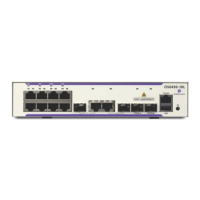Configuring VLAN Stacking Configuring VLAN Stacking Services
OmniSwitch AOS Release 7 Network Configuration Guide March 2011 page 27-13
-> show ethernet-service svlan 300
Service Name : VideoOne
SVLAN : 300
NNI(s) : 2/1, 3/2
SAP Id : 20
UNIs : 1/1, 1/2
CVLAN(s) : 10, 20
sap-profile : sap-video1
SAP Id : 30
UNIs : 1/3
CVLAN(s) : 30, 40
sap-profile : sap-video2
To delete a service from the switch configuration, use the no form of the ethernet-service service-name
command. For example, the following command deletes the “Video-Service” service:
-> no ethernet-service service-name Video-Service
Note that when a VLAN Stacking service is deleted, the SVLAN ID association with the service is auto-
matically deleted. However, if one or more VLAN Stacking service access point (SAP) are associated
with the service, remove the SAPs first before attempting to delete the service.
Configuring VLAN Stacking Network Ports
The ethernet-service svlan nni command is used to configure a switch port or link aggregate of ports as a
VLAN Stacking Network Network Interface (NNI) and associate the NNI with an SVLAN. For example,
the following command configures port 2/1 as an NNI port and associates 2/1 with SVLAN 300:
-> ethernet-service svlan 300 nni port 2/1
When a port is associated with an SVLAN using this command, the port is automatically defined as an
NNI to carry traffic for the specified SVLAN. In addition, the default VLAN for the port is changed to a
VLAN that is reserved for the VLAN Stacking application. At this point, the port is no longer config-
urable using standard VLAN port commands.
To delete an NNI port association with an SVLAN, use the no form of the ethernet-service svlan nni
command. For example, the following command deletes the NNI 2/1 and SVLAN 300 association:
-> no ethernet-service svlan 300 nni port 2/1
Note that when the last SVLAN association for the port is deleted, the port automatically reverts back to a
conventional switch port and is no longer VLAN Stacking capable.
Use the show ethernet-service command to verify the NNI port configuration for the switch.
Configuring NNI Port Parameters
The ethernet-service nni command is used to configure the following parameters that apply to traffic
processed by NNI ports:
• tpid—Configures the vendor TPID value for the SVLAN tag. This value is set to the default and is
applied to traffic egressing on the NNI port and is compared to the SVLAN tag of packets ingressing
on the NNI port. If the configured NNI TPID value and the ingress packet value match, then the packet
is considered an SVLAN tagged packet. If these values do not match, then the packet is classified as a
non-SVLAN tagged packet.

